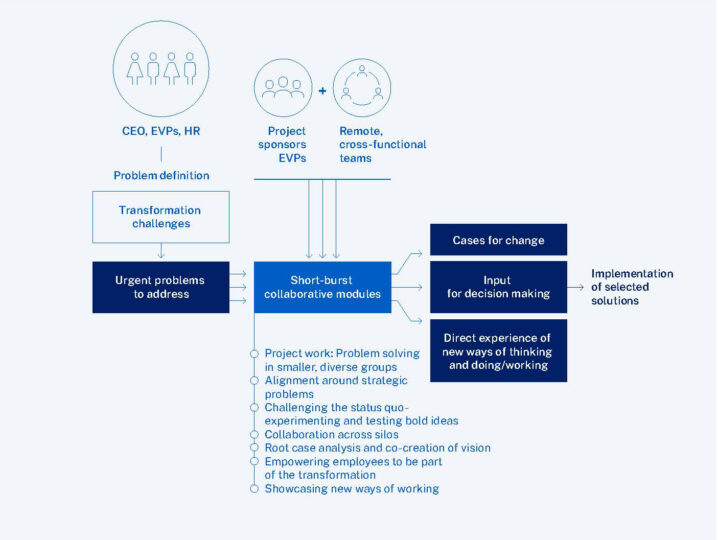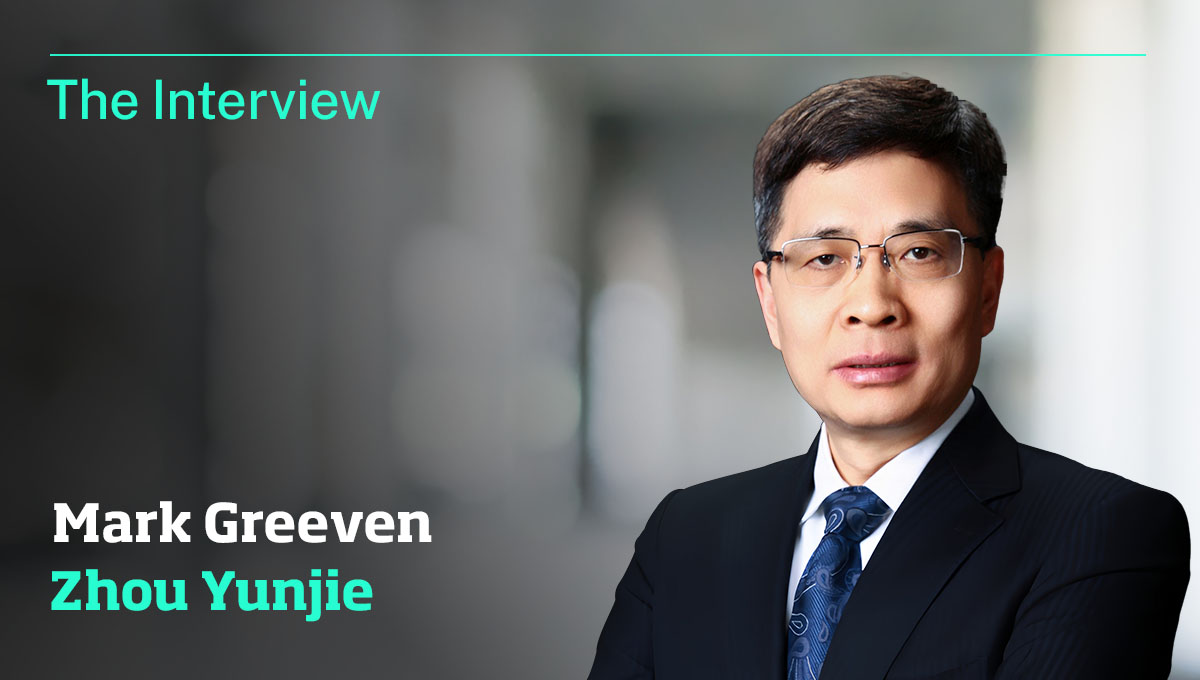
In the field with Statkraft
At a glance
- With the worldwide transition from fossil fuels to green sources of energy, intensifying decarbonization efforts, and disruptions in long-term energy supplies from Russia, the demand for Statkraft’s products, services and solutions in 2022 grew exponentially.
- In response, the company put forward an ambitious growth strategy, multiplying the projected volume of its renewable energy production. Traditionally a Nordic hydropower player, it also ramped up its worldwide expansion into new sectors such as hydro, solar, wind, offshore wind, hydrogen and biofuels.
- Statkraft now had to manage an unprecedented level of complexity. From a siloed structure, it began morphing into a more matrixed organization. Accordingly, behaviors associated with agility, speed and collaboration came to the forefront of the transformation agenda.
Few companies ever find themselves in the enviable position where supply can barely keep up with the demand for their products. Yet Statkraft, based in Norway and a leading hydropower company globally, is in just such a situation. Moreover, Statkraft’s credentials in the renewables space – its standing as Europe’s largest and aggressively internationalizing provider and its tradition of excellence and of delivering “110%” quality to clients – are impeccable. Nonetheless, organizationally, Statkraft has found itself entering new territory and gradually moving away from its traditional, successful business model of long-standing stability and of business units operating as de facto independent entities, which had stood the company in good stead for more than a century. What actions and initiatives did it adopt in order to nurture a culture of collaboration, both within and across its organizational divisions?
Essentially it is all about you: Your goals, your development, and your role in the future of Statkraft.
– Statkraft’s renewed Goal and Development (G&D) statement
The broader issue
Knowing why, where and how to collaborate – particularly across business units
In a VUCA world of volatility, uncertainty, complexity and ambiguity, along with ever-more sophisticated client expectations, collaboration can indeed unlock tremendous opportunities. For most businesses, it has become a strategic tool to achieve desired outcomes such as growth, speed and the ability to navigate complex terrains. In these new business landscapes and high-growth settings, collaboration has been emphasized as a gateway to enhanced efficiency, knowledge sharing, innovation and improved decision making.
It is equally important, however, that organizations approach collaboration skillfully, with a nuanced understanding of several issues:
- Collaboration past and present: Where was/is it required and not required?
- Collaboration across silos: This can be essential for high-complexity projects, cross-functional initiatives and certain managerial situations because it can mobilize diverse expertise, resources and perspectives to achieve organizational objectives.
- Collaborative ethos: Collaboration should not undermine the autonomy, continuity and decision-making authority of silos as deep reservoirs of efficiency and engineering knowledge and expertise.
Affirming collaboration as a core value
Conceptually, Statkraft’s central leadership understood that collaborating within a matrix could empower high-performing teams to be more productive as well as more adept at solving problems. In keeping with this vision, the company reformulated its core values, optimizing them for the good of the entire organization:
- We act responsibly.
- We grow together.
- We make an impact.
Applying different levers to boost collaboration
Strategy and governance: Clear definition of accountability
In Statkraft’s new, agile incarnation, getting things done is no longer exclusively about authority and the chain of command. Instead, managers and teams are encouraged to participate in the company’s broader strategy network, engage and build relationships with colleagues and experts from across the organization, and prioritize specific activities. Teams are tasked with defining their own goals and outcomes. Similarly, processes, information and responsibility are getting pushed out to country operations whose heads do not just “coordinate” as they might have in the past. Collaborating with others thus becomes both an opportunity and a responsibility.
Collaborative scorecard
Concurrently, Statkraft introduced a collaborative scorecard. Employees are encouraged to complete the scorecard in a meaningful way as part of their annual goal-setting dialog. Whatever the self-defined goal, collaboration should stand for at least 15% of the scorecard’s behavioral (as opposed to performance-related) indicators. For 2022, employees were expected to specify at least one behavioral goal related to collaboration.
Designing for experimentation
To empower employees to see the value proposition of collaboration, and to try out different collaborative tools and techniques in the confines of safe playgrounds and other controlled environments, Statkraft piloted a number of experimental activities. These combined new learning channels with fun and games, and also served as a showcase for the rest of the organization. For example, the company launched Boostr – a program comprising a series of tech-enabled short-burst collaboration modules facilitated by innovation experts (see Figure 1).
A hackathon-style problem-solving module using virtual communication platforms and Miro boards, Boostr was an opportunity to show employees that the upcoming transformation was not happening to them – but rather, they were the ones driving it forward. To quote a Boostr participant:
This approach truly makes our people see the value of collaborating, wherever they may sit in Statkraft. They are actually finding the common solution – and crucially, because they really want to, not because they have to.
Figure 1: Structure of a BOOSTR module

Entering new value chains and ecosystems
For renewable energy to remain a cornerstone of the energy transition, Statkraft increasingly needs to combine the use of renewables with a wealth of technological systems. For example, in offshore wind projects, the initiative to develop offshore, or floating, wind farms on a global scale saw Statkraft join a consortium of companies contributing their respective experience in offshore development, marine operations, renewable energy development, operations and management, and execution. The consortium covers the full value chain from development to delivery of offshore clean energy to market. This is yet another arena where collaborative skills and behaviors are promising to produce a significant payoff for the company.
Did it work?
By 2023, Statkraft was well on its way to becoming one of the global leaders in renewable energy. The group’s net operating revenues for 2022 rose nearly 80% on the previous year, to reach a record high of NOK 73.9 billion (US$7.7 billion). The company announced a series of ambitious investments in key markets in Europe and around the world. It also entered into groundbreaking power purchase agreements (PPAs) with major corporations including Microsoft, Daimler and Mercedes-Benz.
Further expanding the firm’s technological capability, Statkraft Ventures is looking after a portfolio of almost two dozen climate tech and energy companies in Europe and North America and aiming to add more. In 2022, its portfolio companies raised more than €300 million from large global investors including GIC and Goldman Sachs.
Internally, Statkraft’s executives remain optimistic about pushing boundaries and stretching the organization’s muscles of collaboration, agility and adaptability. They have put together a Future Board – a group of young workers whose motto is, “Less talking, more doing,” with a mandate to advise the CEO and top management, thus infusing the company’s strategy with future-ready perspectives.
Takeaways
- Do not let collaboration become a buzzword that means all things to all people. Particularly in cross-division collaboration, ask yourself and your team: How much collaboration is needed? What practices should receive priority, and based on what criteria?
- Be clear on the degree of autonomy that business areas can productively maintain amid transformation towards a collaborative culture. What is the “sweet spot” where business units can still be aligned with the company’s purpose and overarching business goals? Ultimately, autonomy and alignment should emerge as functions of each other, instead of working at cross-purposes.
- Explore new ways for leadership to narrate and model the long-term case for collaboration.
- By engaging in experiments, your workforce will be empowered to focus on what matters, prioritize on the go, create solutions to real-world challenges at speed, take part in strategy-making at scale, learn to share resources across departments, modify behaviors in action, develop the skills and mindsets of the future, experience a shared sense of purpose, and double down on quintessentially human qualities such as curiosity, associative thinking and empathy.
This article is based on the IMD case IMD-7-2432, available from The Case Centre at this link.
Reference reading
Muhdi, L. (2022). How to jump-start innovation and organizational change. Available at this link.
Research Information & Knowledge Hub for additional information on IMD publications

Six ways leaders can shape corporate reputation building strategies within their organizations, drawing on key insights from a Bloomberg Media study.

Haier's CEO Zhou Yunjie explains how the company's innovative RenDanHeYi model empowers employees, drives global growth, and adapts to market changes.

To navigate a turbulent business environment, CEOs must understand their landscape and align leadership thinking priorities, advises IMD’s Michael Watkins.
Case B describes the unprecedented challenges faced by CO-RO in 2020. The implementation of the sugar tax in its largest Middle Eastern market led to a near 50% volume drop in CO-RO’s sales, and Covid-19 lockdowns impacted the Asia-Pacific (APAC) ...
The CO-RO Group is a manufacturer of fruit-based still drinks, concentrates and ambient ice (home-freeze popsicles) headquartered in Denmark. Although production takes place in Denmark, most of its products are sold internationally, with the compa...
The case explores TBC Bank Group’s remarkable journey from a small Georgian bank to a regional leader in digital financial services across Central Asia. Founded in 1992 with just US$500 in initial capital, TBC evolved into Georgia’s largest financ...

Understand how GenAI is different from other tech innovations and what you can do to harness its power. This book argues that GenAI represents a genuine paradigm shift in technological innovation. The authors, the hosts of the popular podcast ‘Mik...
The board of Nestlé S.A. announced that Anna Mohl would become the CEO of Nestlé Health Science (NHSc) — a global leader in nutritional science — on 1 January 2024. She was delighted to hear about her new position but knew there was little time to...

In this summarized extract from their book The Art of Thinking in a Digital World, Luc de Brabandere, Jonas Leyder, and Lina Benmehreze explain how true creativity begins by looking at the same thing in a different way.
Chinese start-up DeepSeek sent shock waves through global markets in January, with its latest artificial intelligence breakthrough causing a nearly $600 billion rout in Nvidia’s market value. The company has since recouped some of those market los...
in I by IMD
Research Information & Knowledge Hub for additional information on IMD publications
Research Information & Knowledge Hub for additional information on IMD publications
Research Information & Knowledge Hub for additional information on IMD publications
Research Information & Knowledge Hub for additional information on IMD publications
Research Information & Knowledge Hub for additional information on IMD publications
Research Information & Knowledge Hub for additional information on IMD publications
Research Information & Knowledge Hub for additional information on IMD publications
Case reference: IMD-7-2636 ©2025
Research Information & Knowledge Hub for additional information on IMD publications
in I by IMD Brain Circuits 13 February 2025
Research Information & Knowledge Hub for additional information on IMD publications
Research Information & Knowledge Hub for additional information on IMD publications

